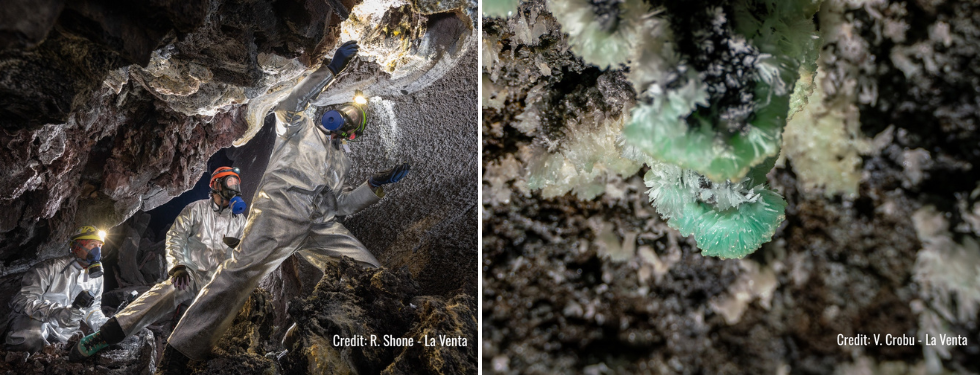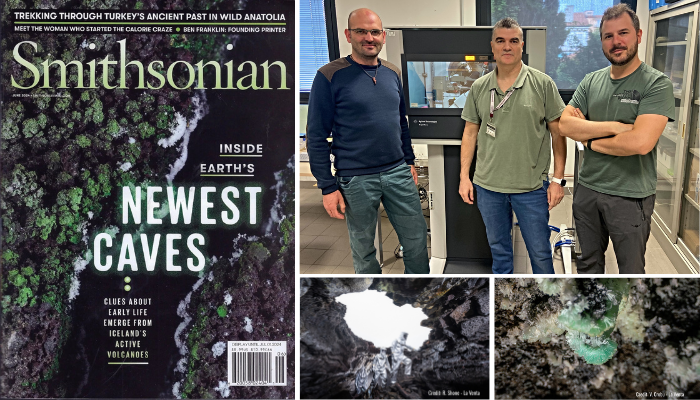Unveiling early life on our planet through the youngest lava tubes

In 2021, the stunning eruption of the Fagradalsfjall volcano, in southwest Iceland, captivated a global audience. After lying dormant for 800 years, the volcano's six-month-long eruption was just the beginning. Subsequent eruptions have signaled a new phase for the Reykjanes Peninsula, drawing significant media attention. However, this magmatic awakening has raised safety concerns for the region's inhabitants.
The 39-year-old geologist and speleologist Francesco Sauro promptly recognized the scientific potential of the Fagradalsfjall volcano's activity. Throughout his career, he has extensively explored more than 60 miles of caves globally, collaborating with NASA and ESA to help train astronauts in planetary exploration.
Sauro, president of the La Venta Geographic Exploration Association, didn’t want to miss the chance to explore one of the Earth’s youngest caves, formed of lava tubes created by materials from the Fagradalsfjall volcano eruption.
“These caves are built in an instant of geologic time,” Sauro explained in an interview with Smithsonian magazine, which dedicated the cover of its latest issue to the subject. It's like having an amazing laboratory where you can understand cave formation processes, observe the cooling of lava, and study the mineralogical and ecological evolution of extreme environments.
Speleologists understood the importance of being on-site promptly in such circumstances. Delaying could lead to the loss of valuable minerals as temperatures decrease. The example of the lava tubes created after the 1993 eruption of Mount Etna in Italy served as a valuable lesson for scientists.
After initially studying the volcano remotely using images captured by aircraft, drones, and satellites, Francesco Sauro and his colleagues from La Venta traveled to Iceland to explore new caves and collect mineral samples. In November 2022, Sauro was awarded with a National Geographic Society Grant in support of the "Hraunrásir" project to study the mineralogy and biology of newly formed lava tubes. Leading an international team of experts, Sauro conducted several expeditions, with the most complex one taking place in June 2023.

To enter the caves, the scientists had to wear metallurgist suits designed to withstand high temperatures and breathing from portable tanks filled with compressed air, because the air inside was too hot and laden with toxic gases.
Studying newly formed lava tubes may be crucial for two relevant lines of research. The first focuses on mineralogical aspects to understand the possible origin of the minerals present in the caves. Concerned that certain minerals might alter or vanish over time, the researchers brought a scanning electron microscope to the site to generate high-resolution images of the samples, aiding in their identification.
The samples underwent additional sophisticated analyses at the Department of Geosciences laboratories at the University of Padua. The research was led by Professor Fabrizio Nestola, in collaboration with Professor Matteo Massironi and researcher Riccardo Pozzobon. One mineral of particular interest was wulffite, an emerald-green crystal whose composition includes sodium and potassium along with copper sulfate.
"It has only been found once in the history of mineralogy, in a Russian volcano site," remarks Fabrizio Nestola, Professor of Mineralogy who was recently awarded the prestigious Dana Medal and the title of Geochemistry Fellow 2024. Nestola also expressed his belief that certain minerals will likely be entirely new to science, potentially revealing as yet unknown processes by which mineralization takes place.
Another line of research focuses on microbiological aspects of newly formed caves to comprehend their potential to support life. A large amount of bacteria has been discovered in the oldest lava tubes. Studying these organisms could help researchers refine their ideas about how life developed on Earth. It could also provide insight into where to search for signs of life on other planets, such as Mars.
Furthermore, the fascination with lava tubes continues to grow due to their existence in the subsurfaces of the Moon and Mars, as they may offer the potential to host complete planetary bases for human exploration. “One of the key benefits of their potential utilization is their capacity to protect from cosmic and solar radiation, a refuge from micrometeorites that regularly strike planetary surfaces, and a temperature-stable internal environment unaffected by variations between night and day” remarks Riccardo Pozzobon, which has been studying the genesis and morphometry of lava tubes on Earth and their analogues on the Moon and Mars since in the last years.





